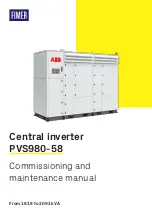
27
SAMLEX AMERICA INC. | 27
seCtIOn 7 |
General Information on lead Acid
Batteries
7.16 SiZinG tHe inVeRteR BAtteRY BAnK
one of the most frequently asked questions is, "how long will the batteries last?" This
question cannot be answered without knowing the size of the battery system and the
load on the inverter. Usually this question is turned around to ask “How long do you
want your load to run?”, and then specific calculation can be done to determine the
proper battery bank size.
There are a few basic formulae and estimation rules that are used:
1.
Active Power in Watts (W) = Voltage in Volts (V) x Current in Amperes (A)
x Power factor.
2.
for an inverter running from a 12V battery system, the approximate DC current re-
quired from the 12V batteries is the AC power delivered by the inverter to the load
in Watts (W) divided by 10 & for an inverter running from a 24V battery system, the
approximate DC current required from the 24V batteries is the AC power delivered
by the inverter to the load in Watts (W) divided by 20.
3.
Energy required from the battery = DC current to be delivered
(A) x Time in Hours (H).
The first step is to estimate the total AC watts (W) of load(s) and for how long the
load(s) will operate in hours (H). The AC watts are normally indicated in the electrical
nameplate for each appliance or equipment. In case AC watts (W) are not indicated, for-
mula 1 given above may be used to calculate the AC watts. The next step is to estimate
the DC current in Amperes (A) from the AC watts as per formula 2 above. An example
of this calculation for a 12V inverter is given below:
Let us say that the total Ac Watts delivered by the inverter = 1000W.
Then, using formula 2 above, the approximate DC current to be delivered by the 12V
batteries = 1000W ÷10 = 100 Amperes, or by 24V batteries = 1000W ÷ 20 = 50A.
next, the energy required by the load in Ampere Hours (Ah) is determined.
for example, if the load is to operate for 3 hours then as per formula 3 above, the
energy to be delivered by the 12V batteries = 100 Amperes × 3 Hours = 300 Ampere
Hours (Ah), or by the 24V batteries = 50A x 3 Hrs = 150 Ah.
now, the capacity of the batteries is determined based on the run time and
the usable capacity.
from Table 7.3 “Battery Capacity versus Rate of Discharge”, the usable capacity at
3 Hour discharge rate is 60%. Hence, the actual capacity of the 12V batteries to
deliver 300 Ah will be equal to: 300 Ah ÷ 0.6 = 500 Ah, and the actual capacity of the
24V battery to deliver 150 Ah will be equal to 150 Ah ÷ 0.6 = 250 Ah.
And finally, the actual desired rated capacity of the batteries is determined based on
the fact that normally only 80% of the capacity will be available with respect to the
rated capacity due to non availability of ideal and optimum operating and charging
conditions. So the final requirements will be equal to:
26
27
Summary of Contents for PST-300S-12E
Page 102: ...102 51 OPMERKINGEN 102...
Page 153: ...153 HINWEISE 153...
Page 204: ...204 51 NOTES 204...
Page 255: ...255 51 NOTAS 255...
Page 256: ...256 256 www samlex com www samlex solar com 256...
















































